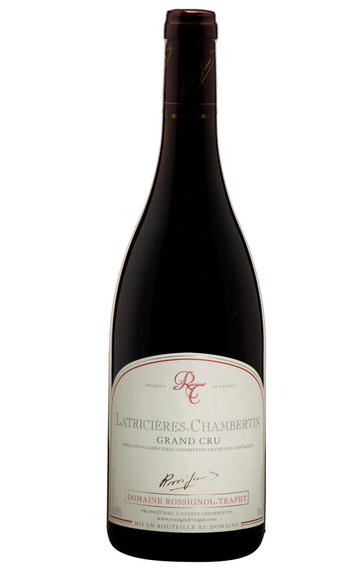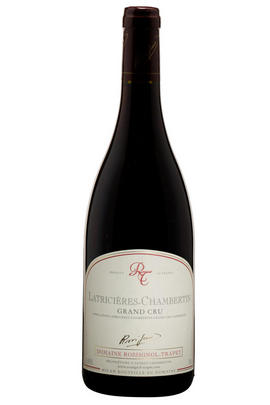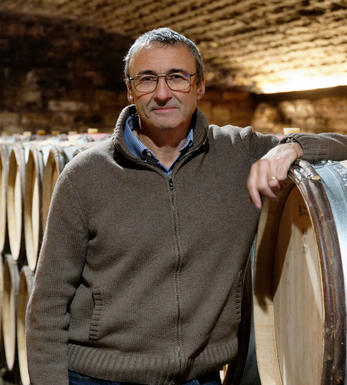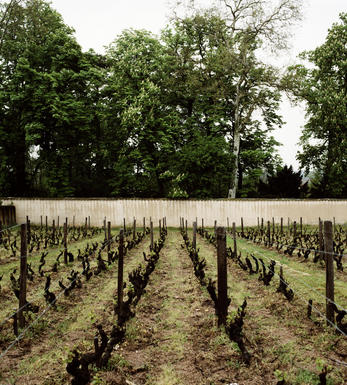
2015 Latricières-Chambertin, Grand Cru, Domaine Rossignol-Trapet, Burgundy

Critics reviews
Medium deep colour, the nose is a little bit sombre, slight cork taint. Some liquorice behind, huge intensity, just not quite pure enough up front, but I like the intensity of the fruit at the finish.
Jasper Morris MW, Inside Burgundy (September 2018)
From vines planted in 1955.
This is the first wine to display any appreciable reduction and it's quite firm. The backward and brooding mineral-suffused middle weight plus flavors terminate in a disjointed, awkward slightly tough and firm finish though I suspect that this is due primarily to the abundant gas. The underlying material appears to be excellent but given how hard this is to read today I would prefer to be cautious.
Drink from 2030 onward
Allen Meadows, Burghound.com (January 2017)
The 2015 Latricières-Chambertin Grand Cru has a very attractive bouquet of red berry fruit, brown spices, cold stone, and a touch of sous-bois, all well-defined and endowed with a surfeit of charm. The palate is medium-bodied with very fine tannin, conveying the more masculine nature of this grand cru vineyard, yet with precision and detail flowing through the finish. Excellent, but it needs several years in bottle. Tasted blind at the annual Burgfest tasting.
Drink 2022 - 2045
Neal Martin, Vinous.com (November 2018)
Cask sample. Biodynamic.
Mid crimson. Sweet red fruit and oak spice. Dry and firm on the palate but deliciously fresh and refined. Not a powerhouse but shapely in a lean sort of way and persistent.
Drink 2022 - 2032
Julia Harding MW, JancisRobinson.com (January 2017)
The 2015 Latricières-Chambertin Grand Cru is stunning stuff and has both incredible aromatics as well as a seamless, heavenly style on the palate. Sweet red fruits, spring flowers, spice, and just a hint of forest floor all emerge from the glass, and it hits the palate with medium to full-bodied richness, flawless balance, ultra-fine tannins, and a beautiful finish. This magical Chambertin has the ripeness of the 2015 vintage as well as terrific overall freshness and purity. You can safely drink this beauty today or cellar bottles for another 10-15 years or more.
Drink 2019 - 2034
Jeb Dunnuck, JebDunnuck.com (November 2019)
About this WINE

Domaine Rossignol-Trapet
Brothers Nicolas and David Rossignol have run this domaine, created by the marriage of their parents, since 1990. The range offers a fine overview of Gevrey-Chambertin terroir, capped by their three, very contrasting, Grands Crus. The Chambertin stands supreme, but a preference between Latricières and La Chapelle varies from year to year.
In the vineyard
The brothers began their move towards biodynamics in ’97 in their Chapelle-Chambertin vineyard; the whole domaine was converted by 2004. They value that status deeply; the work required in ’18 to combat the pervasive mildew was a true labour of love, with endless applications – by hand – of horsetail teas.
In the winery
Over the years, their style has defined itself: these are now relatively delicate wines, lightly extracted so never deep in colour, but built around subtle textures. Aromatics are further enhanced using about 50% whole bunches, depending on the year.

Gevrey-Chambertin
Gevrey-Chambertin is the largest wine-producing village in Burgundy’s Côte d'Or, with its vineyards spilling over into the next door commune of Brochon.
Located in the far north of the Côtes de Nuits above Morey-St Denis, classic Gevrey-Chambertin is typically deeper in colour, firmer in body and more tannic in structure than most red Burgundy. The best can develop into the richest, most complete and long-lived Pinot Noir in the world. This is largely thanks to the iron-rich clay soils, though much depends on whether the vineyard is located on either the steeper slopes (Evocelles, Clos St Jacques) or the flatter, richer soils (Clos Prieur, Combottes).
Whereas in the past there have been numerous underperformers in Gevrey-Chambertin exploiting the reputation of this famous village and its iconic Grands Crus, today there are many fine sources to choose from, and overall quality is higher than ever.
Gevrey-Chambertin’s greatest Grand Cru is named after the field of the monk Bertin (Champ de Bertin). In 1847, Gevrey appended the name of this illustrious vineyard, Chambertin, setting a trend for the other principle villages to follow. Le Chambertin may not be quite as sumptuous as Musigny or Richebourg, or as divinely elegant as La Tâche or Romanée-St Vivant, but it is matched only by the legendary Romanée-Conti for completeness and luscious intensity.
In all, Gevrey boasts an impressive nine Grands Crus, with the name of Chambertin retaining a regal omnipresence throughout its finest vineyard names. The other truly great Grand Cru is Chambertin-Clos de Bèze which has the right to sell its wines simply as ‘Chambertin’, and is the only wine allowed to put the Chambertin name before, rather than after, its own. Situated slightly further up the hill, the wines are fractionally less powerful yet full of sensual charm and finesse.
Quality-wise the next best are generally acknowledged to be Mazis-Chambertin and Latricières-Chambertin. The former is incredibly concentrated and very fine, but its structure is a little less firm than Le Chambertin. Latricières is less about power (although it can be explosively fruity) and more about an entrancing silkiness.
Situated slightly higher up the slope, Ruchottes-Chambertin is impressively rich, stylish and slightly angular. The tiny Griottes-Chambertin, which owes its name to the grill-pan shape of the vineyard rather than the wine’s griotte cherry aroma, is lower down the slope and boasts a velvety texture and rich fruit reminiscent of Chambertin itself. It is generally better than the lighter, although wonderfully fragrant Chapelle-Chambertin and Gevrey’s largest Grand Cru, the pure and seductive (if variable) Charmes-Chambertin.
Gevrey also has some outstanding Premier Crus on the south-east-facing slopes above the town. Les Cazetiers and especially Clos St Jacques produce some exceptional wines. Indeed Armand Rousseau, who pioneered domaine bottling here in the 1930s and is still one of the region’s very best producers, often sells his Clos St Jacques for more than several of his Grand Crus.
Drinking dates for these wines vary, but Grand Crus are generally best from at least 10 to 25 years, Premier Crus from eight to 20 years, and village wines from five to 12 years.
- 315 hectares of village Gevrey Chambertin
- 84 hectares of Premier Cru vineyards (20 in all). The foremost vineyards include Clos St Jacques, Lavaux St Jacques, Combottes, Corbeaux, Cherbaudes, Cazetiers.
- 55 hectares of Grand Cru vineyards: Chambertin, Chambertin Clos de Bèze, Latricières-Chambertin, Ruchottes-Chambertin, Mazis-Chambertin, Charmes-Chambertin, Mazoyères-Chambertin, Chapelle-Chambertin, Griottes-Chambertin..
- Recommended producers: Bachelet, Dugat, Esmonin, Mortet, Rossignol Trapet, Rousseau, Serafin, Bernstein
- Recommended restaurants : Chez Guy (good wine list), Rôtisserie du Chambertin (and Bistro)

Pinot Noir
Pinot Noir is probably the most frustrating, and at times infuriating, wine grape in the world. However when it is successful, it can produce some of the most sublime wines known to man. This thin-skinned grape which grows in small, tight bunches performs well on well-drained, deepish limestone based subsoils as are found on Burgundy's Côte d'Or.
Pinot Noir is more susceptible than other varieties to over cropping - concentration and varietal character disappear rapidly if yields are excessive and yields as little as 25hl/ha are the norm for some climats of the Côte d`Or.
Because of the thinness of the skins, Pinot Noir wines are lighter in colour, body and tannins. However the best wines have grip, complexity and an intensity of fruit seldom found in wine from other grapes. Young Pinot Noir can smell almost sweet, redolent with freshly crushed raspberries, cherries and redcurrants. When mature, the best wines develop a sensuous, silky mouth feel with the fruit flavours deepening and gamey "sous-bois" nuances emerging.
The best examples are still found in Burgundy, although Pinot Noir`s key role in Champagne should not be forgotten. It is grown throughout the world with notable success in the Carneros and Russian River Valley districts of California, and the Martinborough and Central Otago regions of New Zealand.


Buying options
Add to wishlist
Description
With a rich purple colour, this has a firm, concentrated nose. Then it swells incredibly on the palate, unbelievably dense and plump yet with a great line, really long. Yes, please. There is a wonderful wealth of fruit to this, a glamorous sense of luxury but it’s very stylish. There is plenty of purple fruit, black cherries and a good natural acid balance.
Nicolas and David Rossignol report a healthy crop in quality and quantity, though a little reduced in the Grands Crus. They began on 7th September, using around 50 percent whole bunches, and avoided any punching down during vinification as there was no need to search for extraction, preferring a daily pumping-over and aeration. As ever there is only a modest use of new oak and sulphur levels are kept low. They have made unquestionably brilliant wines this year.
Drink 2025 - 2035
Berry Bros. & Rudd
wine at a glance
Delivery and quality guarantee